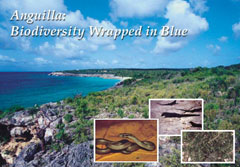|
Anguilla: Biodiversity Wrapped in Blue
Anguilla, the most northerly of the Leeward Islands, is located 18.3º north by 63º west. Its name derived from its eel-shape. The coral limestone island’s area is 91km2, together with several offshore islands and cays. Anguilla is home to 13,527 people (estimated 1999). Tourism and off-shore finance are the major contributors to the island’s economy.
The Anguilla National Trust was established in 1993 to act as custodian of Anguilla's heritage, preserving and promoting the island's natural environment and its archaeological, historical and cultural resources for present and future generations. The Trust is working to oversee the management of all National Parks, Protected Areas, Heritage Sites/Buildings and the National Museum; establish Environmental Education Programmes for all Anguillians; and promote and preserve the expression of Anguillian culture; provide advice on matters relating to natural, cultural and historic resources.
The Trust's Facebook page gives regular updates on project activities such as the Sea Turtle Monitoring Programme; Wetland Bird Monitoring; Adventure Anguilla - a week-long outdoors programme that seeks to raise awareness amongst Anguilla's youth about the importance of and interconnections among the island's land, marine, and coastal ecosystems.
The Anguilla National Trust, through its conservation programme, is collaborating with its regional and international partners, with the major goal of developing a system of parks and protected areas. Inventories of the island’s bird life are in progress. Of utmost importance are Anguilla’s salt ponds. These wetlands are habitat for various bird species, which include the endangered roseate terns, least terns and red-billed tropic birds, a species of special concern. During hurricanes and periods of heavy rains, they act as flood control areas. The offshore cays are very important for breeding seabirds, as well as endemic species.
|
 |
  |
| click images for larger versions |
| The unique ecosystems of Anguilla and its offshore cays are home to several species of birds and reptiles. These include the endemic black lizard (pictured) on Sombrero Island, the harmless Anguillan racer snake (pictured) and the lesser Antillean iguana. About 129 bird species and 520 plant species have been recorded with Rondeletia anguillensis (pictured) classified as an endemic. |
|
Photographs courtesy of Glenn Gerber, Thomas McCarthy, Ivor Hodge (Kandid Photos) and the Department of Physical Planning
|
|
|
|










